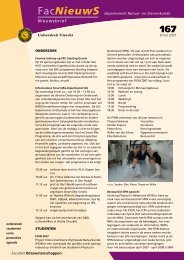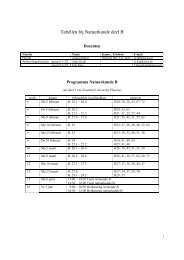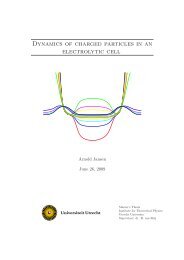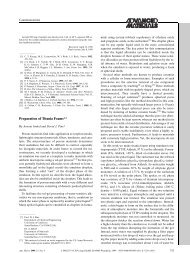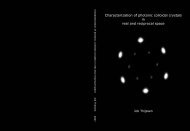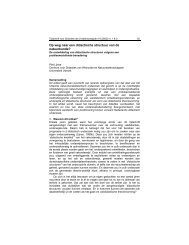Sedimentation Equilibrium of Mixtures of Charged Colloids
Sedimentation Equilibrium of Mixtures of Charged Colloids
Sedimentation Equilibrium of Mixtures of Charged Colloids
You also want an ePaper? Increase the reach of your titles
YUMPU automatically turns print PDFs into web optimized ePapers that Google loves.
numbers for the parameters Z i , L i , σ i , ρ s , λ B and a mean density ¯ρ i to fix a i .By using an iteration method, shown and discussed in chapter 6, a common,four-year-old computer can calculate the solution for a polydisperse system<strong>of</strong> n = 20 components and H = 20cm in a minute. We will now explore somenumerical results, before we continue the analytical path for which we needassumptions.4.3 Binary systemsWe will start with a binary system, i.e. a system with n = 2 colloidalcomponents. The reason for this choice is that, considering these systems,the complexity is still reduced, while several multi-component phenomenacan already be examined. The next examples will show if the componentswill form layers, if they will order, and how their pr<strong>of</strong>iles are influenced whenthey are put together.After careful study three binary systems were selected for comparison. Thegravitational length are fixed at L 1 = 1mm, L 2 = 2mm and Z 1 = 250. Thecharge number Z 2 , however, will be varied, in case (a) Z 2 = 125, in case (b)Z = 500, in case (c) Z = 1000. The calculated density pr<strong>of</strong>iles are shownbelow in figure 4.1, in terms <strong>of</strong> the so-called packing fraction, a dimensionlessdensity that expresses the ratio <strong>of</strong> the volume that is occupied by the colloids,η i (x) = πσ3 i6 ρ i(x). (4.6)The particles <strong>of</strong> component 2 are twice as heavy as the particles <strong>of</strong> component1, and on the basis <strong>of</strong> their gravitational length, component 2 is expected tobe on the bottom. However, due to their charge ratio, other situations mayoccur as well, as is shown. Figure 4.1a shows a strong segregation <strong>of</strong> thecomponents, not a mixture <strong>of</strong> barometric distributions like our atmosphere.Although the heavier component 2 is below component 1, the situation isreversed in figure 4.1c. Apparently independent <strong>of</strong> mass, the colloidal componentscan live together as well in figure 4.1b.How can this be?We cannot see this directly from theory, the ’Donnan-method 2 ’ needed toomany assumptions and the ’PB-method 3 ’ could not be solved analytically.An explanation can still be found after an examination <strong>of</strong> φ(x), or equivalently,the salt pr<strong>of</strong>iles, and related, the electric field (see figure 4.2)2 see section 3.23 see section 3.318



